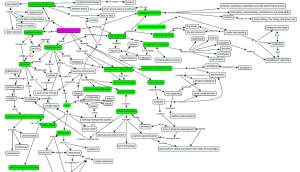ETEC 530 Constructivism
Author: Michele Brannon-HamiltonETEC 530 Constructivism
ETEC 530 covered constructivist learning theory which many MET instructors use to design and teach their courses. I took this course because it best described the elements I use in teaching and designing, particularly online courses.
We started this course by creating a personal profile which included our professional information and an explanation of why we were interested in constructivism. I found it interesting that our instructor was out East which demonstrated the diversity of the instructors and students in this truly global program.
Initially, I was surprised at the scientific aspect of this course and I felt uncomfortable because I didn’t have a science background like many of the other students in the class. However, I learned by asking questions and clarifying assignments which really is a constructivist way of learning.
We discussed the importance of prior learning and in true constructivist form we started our concept maps early on and built them throughout the course as we learned new material. We were also encouraged to keep ongoing reflections for each unit of study. My reflections demonstrated that I believe constructivism includes creation, interaction, communication, collaboration, new knowledge and the new roles of teacher and student.
While developing our concept maps, we learned a program called Cmap tools which can be downloaded and used for free to create concept maps. I found this program challenging at first; however, I was soon impressed by the program’s flexibility as I learned how to add colour, move concepts around and add arrows linking ideas. The Naidu article had a good description of concept mapping, including an explanation of the arrows. Although I had used mind maps in my own work, I didn’t understand the importance of the links until I read this article. I chose my concept map as an artifact because it demonstrates challenges I overcame and it is a good visual represention of my ideas.
In this class, I learned the educational value of metacognition, problem solving, critical thinking and reflection. I found these concepts particularly interesting because I work with several students who are unable to think at this level because of learning disabilities and mild intellectual disability. In today’s fast world of new technology, students need these skills to succeed in and beyond the classroom.
During this course, we used several evaluation tools. Perhaps they are common in science classrooms, but I was unsure how to use the tools and felt intimidated by my lack of knowledge. However, I eventually asked how to use them and found there was a problem with the software. It surprised me that even at a Master’s level I was intimidated by new tools. I will remember this feeling when introducing educational technology to other people.
In this class, I learned there are different types of constructivism including psychological and sociological. The Matthews article referenced below was my first introduction to the theorists associated with constructivism like Piaget, Von Glaserfeld and Vygotsky.
I found it interesting that many of my beliefs about effective education were elements of constructivism like active learning, learner responsibility, and student engagement. An aspect new to me included how students create meaning through assimilation and accommodation.
Next, we looked at constructivist strategies involved in collaborative and individual learning such as problem-based, case-based and project based learning. Using constructivist teaching principles, we were put into groups to investigate these strategies. For example, we used the jigsaw method of learning which included each group member researching a strategy and returning to the group to share as experts and then sharing with the class. Unfortunately, my group wasn’t very interested in developing their new knowledge; therefore, the task was only partially successful which demonstrates a challenge to this type of learning.
Other tasks included researching webquests, webprojects, computer mediated communication, communities of inquiry, cmap construction, gaming and small group activities. We also learned how to evaluate constructivist activities by understanding what we are evaluating such as the key ideas or elements of constructivism. In order to assess effectively, we were given several instructional models to use while evaluating learning activities.
Overall, this course allowed me to put a theoretical name to the ideas I hold about teaching. Similar to constructivists, I value active learning, interaction, creation, collaboration and communication. I found this course very informative and I was able to use elements of constructivist theory for several of my other courses.
Artifacts
Sample of a Constructivist Lesson: Adult Literacy Lesson Level 3 Writing a Complaint Letter
Incorporating Constructivist Elements into an Adult Literacy Classroom
Constructivist Concept Map

